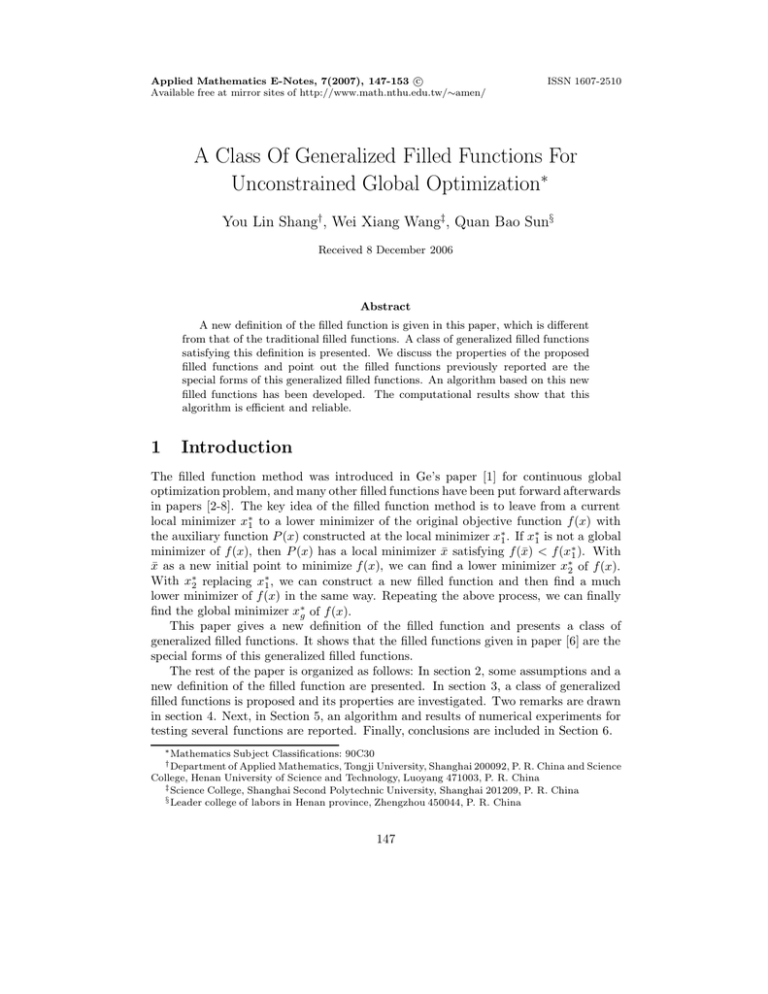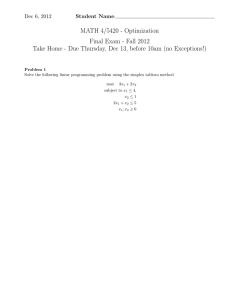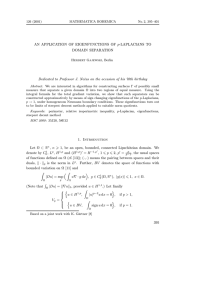Document 10677319
advertisement

c
Applied Mathematics E-Notes, 7(2007), 147-153 Available free at mirror sites of http://www.math.nthu.edu.tw/∼amen/
ISSN 1607-2510
A Class Of Generalized Filled Functions For
Unconstrained Global Optimization∗
You Lin Shang†, Wei Xiang Wang‡, Quan Bao Sun§
Received 8 December 2006
Abstract
A new definition of the filled function is given in this paper, which is different
from that of the traditional filled functions. A class of generalized filled functions
satisfying this definition is presented. We discuss the properties of the proposed
filled functions and point out the filled functions previously reported are the
special forms of this generalized filled functions. An algorithm based on this new
filled functions has been developed. The computational results show that this
algorithm is efficient and reliable.
1
Introduction
The filled function method was introduced in Ge’s paper [1] for continuous global
optimization problem, and many other filled functions have been put forward afterwards
in papers [2-8]. The key idea of the filled function method is to leave from a current
local minimizer x∗1 to a lower minimizer of the original objective function f(x) with
the auxiliary function P (x) constructed at the local minimizer x∗1 . If x∗1 is not a global
minimizer of f(x), then P (x) has a local minimizer x̄ satisfying f(x̄) < f(x∗1 ). With
x̄ as a new initial point to minimize f(x), we can find a lower minimizer x∗2 of f(x).
With x∗2 replacing x∗1 , we can construct a new filled function and then find a much
lower minimizer of f(x) in the same way. Repeating the above process, we can finally
find the global minimizer x∗g of f(x).
This paper gives a new definition of the filled function and presents a class of
generalized filled functions. It shows that the filled functions given in paper [6] are the
special forms of this generalized filled functions.
The rest of the paper is organized as follows: In section 2, some assumptions and a
new definition of the filled function are presented. In section 3, a class of generalized
filled functions is proposed and its properties are investigated. Two remarks are drawn
in section 4. Next, in Section 5, an algorithm and results of numerical experiments for
testing several functions are reported. Finally, conclusions are included in Section 6.
∗ Mathematics
Subject Classifications: 90C30
Applied Mathematics, Tongji University, Shanghai 200092, P. R. China and Science
College, Henan University of Science and Technology, Luoyang 471003, P. R. China
‡ Science College, Shanghai Second Polytechnic University, Shanghai 201209, P. R. China
§ Leader college of labors in Henan province, Zhengzhou 450044, P. R. China
† Department of
147
148
2
Generalized Filled Functions
New Definition of the Filled Function
We consider the following unconstrained programming problem
(P ) min f(x), s.t. x ∈ Rn .
(1)
We assume that the following conditions are satisfied.
ASSUMPTION 1. f(x) is continuously differentiable on Rn .
ASSUMPTION 2. The minimum of f(x) is a finite set.
ASSUMPTION 3. f(x) is coercive, i.e., f(x) → +∞, as k x k→ +∞.
Notice that Assumption 3 implies the existence of a robust compact set Ω ⊂ Rn
whose interior contains all minimizers of f(x). We assume that the value of f(x) for x
on the boundary of Ω is greater than the value of f(x) for any x inside Ω. Then the
original problem (P ) is equivalent to the following problem
min f(x), s.t. x ∈ Ω.
(2)
Throughout the rest of the paper, let x∗1 be the current local minimizer of f(x), L
be the set which consists of all the local minimizers lower than x∗1 of f(x).
DEFINITION 1. A differentiable function P (x, x∗1) is called a filled function of f(x)
at local minimizer x∗1 if P (x, x∗1) has the following properties:
(i) x∗1 is a strictly local maximizer of P (x, x∗1);
(ii) If x ∈ Ω\x∗1 satisfying f(x) ≥ f(x∗1 ), then x is not a stationary point of P (x, x∗1)
and satisfies ∇T P (x, x∗1)(x − x∗1) < 0;
(iii) If x∗1 is not a global minimizer of f(x), then P (x, x∗1) has a minimizer x̄ satisfying
f(x̄) < f(x∗1 );
(iv) If x1, x2 ∈ Ω satisfying f(x1 ) ≥ f(x∗1 ) and f(x2 ) ≥ f(x∗1 ), then kx2 − x∗1k >
kx1 − x∗1 k if and only if P (x2, x∗1) < P (x1, x∗1).
Definition 1 shows that x∗1 is a global minimizer of f(x) if and only if x∗1 is the only
stationary point of P (x, x∗1) and x∗1 is a strictly maximizer of P (x, x∗1). We also know
that if x∗1 is not a global minimizer of f(x), then P (x, x∗1) has a minimizer x̄ satisfying
f(x̄) < f(x∗1 ), therefore, we can obtain a lower local minimizer of f(x) than x∗1 by
minimizing f(x) starting from x̄.
3
A Class of Generalized Filled Functions and its
Properties
In this section we propose a class of generalized filled functions satisfying the Definition
1 and discuss its properties.
For any r > 0 and c > 0, let
c
,
t≥0
g(t, r) =
h(t, c) , −r < t < 0
(3)
0
,
t ≤ −r
Y. L. Shang et al.
149
where h(t, c) is twice continuously differentiable on R and satisfies h(0, c) = c, h(−r, c) =
0, in this case, g(t, r) is continuously differentiable on R and
0
,
t≥0
h0(t, c) , −r < t < 0
(4)
g0 (t, r) =
0
,
t ≤ −r
We define
P (x, x∗1, r, A) = exp(−Akx − x∗1 k2) · g(f(x) − f(x∗1 ), r),
(5)
P (x, x∗1, r, A)
where r and A > 0 are two parameters. Next we will show that
is a filled
function satisfying Definition 1 under certain conditions of the parameters r and A.
THEOREM 1. For any r > 0 and A > 0, x∗1 is a strictly local maximizer of
P (x, x∗1, r, A).
PROOF. Since x∗1 is a local minimizer of f(x), there exists a neighborhood of x∗1,
N (x∗1 , δ) = {x| kx − x∗1 k < δ} with δ > 0. For any x ∈ N (x∗1 , δ) \ x∗1 , we have
f(x) ≥ f(x∗1 ) and
g(f(x) − f(x∗1 ), r) = c = g(f(x∗1 ) − f(x∗1 ), r),
exp(−Akx − x∗1k2 ) < exp(−Akx∗1 − x∗1k2 ),
therefore P (x∗1, x∗1 , r, A) > P (x, x∗1, r, A) holds for any r > 0 and A > 0, i.e., x∗1 is a
strictly local maximizer of P (x, x∗1, r, A).
THEOREM 2. If x ∈ Ω \ x∗1 satisfying f(x) ≥ f(x∗1 ), then x is not a stationary
point of P (x, x∗1, r, A) and ∇T P (x, x∗1, r, A)(x − x∗1 ) < 0.
PROOF. It follows from formulation (5) that
∇P (x, x∗1, r, A) =
exp(−Akx − x∗1 k2) · [−2A(x − x∗1 ) · g(f(x) − f(x∗1 ), r)
+g0 (f(x) − f(x∗1 ), r) · ∇f(x)].
For any x ∈ Ω \ x∗1 satisfying f(x) ≥ f(x∗1 ) we have
∇P (x, x∗1, r, A) = −2cA · exp(−Akx − x∗1 k2) · (x − x∗1 ) 6= 0,
i.e., x is not a stationary point of P (x, x∗1, r, A) and
∇T P (x, x∗1, r, A)(x − x∗1 ) = −2cA · exp(−Akx − x∗1 k2) · kx − x∗1 k2 < 0.
THEOREM 3. If x∗1 is not a global minimizer of f(x), then P (x, x∗1, r, A) has a
local minimizer x̄ satisfying f(x̄) < f(x∗1 ) when r ≤ β20 and A > 0, where
β0 = max(f(x∗1 ) − f(x)).
x∈L
Furthermore, x̄ satisfies the inequality P (x̄, x∗1, r, A) < P (x∗1 , x∗1, r, A).
PROOF. Since x∗1 is not a global minimizer of f(x), L 6= 0. It follows from Assumption 2 that there exists a x̄ ∈ L such that β0 = f(x∗1 ) − f(x̄). When r ≤ β20 , we
have
f(x̄) − f(x∗1 ) = −β0 ≤ −2r < −r,
150
Generalized Filled Functions
and
P (x̄, x∗1, r, A) = 0.
Since f(x) is a continuously function on Rn , there exists a neighborhood of x̄, N (x̄, δ),
for any x ∈ N (x̄, δ), we have f(x) − f(x∗1 ) < −r and
P (x, x∗1, r, A) = 0.
Therefore, x̄ is a local minimizer of P (x, x∗1, r, A) satisfying
P (x̄, x∗1 , r, A) = 0 < c = P (x∗1, x∗1 , r, A).
THEOREM 4. If x1, x2 ∈ Ω satisfying f(x1 ) ≥ f(x∗1 ) and f(x2 ) ≥ f(x∗1 ), then
kx2 − x∗1 k > kx1 − x∗1k if and only if P (x2, x∗1, r, A) < P (x1, x∗1, r, A).
PROOF. It follows from f(x1 ) ≥ f(x∗1 ) and f(x2 ) ≥ f(x∗1 ) that
P (x1, x∗1, r, A) = c · exp(−Akx1 − x∗1 k2),
and
P (x2, x∗1, r, A) = c · exp(−Akx2 − x∗1 k2).
Therefore, kx2 − x∗1k > kx1 − x∗1 k if and only if P (x2, x∗1, r, A) < P (x1, x∗1, r, A).
From Theorems 1-4, we know that when r ≤ β20 and A > 0, function P (x, x∗1, r, A)
is a filled function satisfying the new Definition 1.
4
Two Remarks
REMARK 1. If function h(t, c) has the following form
2c 3 3c 2
t − 2 t + c.
r3
r
(6)
qc
(q + 1)c 2m
· t2m+1 −
· t + c, (m > 1, q ∈ N ),
r2m+1
r2m
(7)
h(t, c) = −
or general form
h(t, c) = −
from formulation (3) and (5) we can obtain the filled function P (x, x∗1, r, A) which has
forms given in paper [6], i.e., the filled functions given in paper [6] are the special forms
of this generalized filled functions.
REMARK 2. We can propose another general form of the filled function satisfying
Definition 1, let
d
,
t≥0
N (t, d) , −r < t < 0
M (t, r) =
(8)
t+r ,
t ≤ −r
where N (t, d) is twice continuously differentiable on R, and N (0, d) = d, N (−r, d) = 0,
in this case, M (t, r) is a continuously differentiable on R and the function
φ(x, x∗1, r, A) =
exp(−Akx − x∗1 k2) · g(f(x) − f(x∗1 ), r)
+M (f(x) − f(x∗1 ), r)
(9)
Y. L. Shang et al.
151
is also a class of generalized filled functions satisfying Definition 1. When
r−2 3 r−3 2
· t + 2 · t + d,
(10)
r3
r
the φ(x, x∗1, r, A) has another form given in paper [6], the filled function given in paper
[6] is also the special form of this generalized filled function by (9).
N (t, d) =
5
Algorithm and Numerical Results
The theoretical properties of the new filled function P (x, x∗1, r, q) discussed in the foregoing sections give us an approach for finding a global minimizer of f(x). We present
an algorithm similar to paper [8] in the following:
ALGORITHM 1[8]. (Filled function method)
1. Initial Step
Choose r = 12 , and 0 < r0 < 1 as the tolerance parameter for terminating the
algorithm.
Choose direction ei , i = 1, 2, · · · , k0 with integer k0 > 2n, where n is the number of
variable.
Choose an initial point x01 ∈ Ω.
Let k = 1.
2. Main Step
10 . Obtain a local minimizer of prime problem (P) by implementing a local downhill
search procedure starting from x0k . Let x∗k be the local minimizer obtained. Let i = 1
and r = 12 .
20 . If i ≤ k0 then go to 40 , otherwise go to 30
30 . If r ≤ r0 then terminate the iteration, the x∗k is the global minimizer of problem
(P), otherwise, let r = r/10, i = 1, go to 40.
40 . x̄∗k = x∗k + δei (where δ is a very small positive number), if f(x̄∗k ) < f(x∗k ) then
Let k = k + 1, x0k = x̄∗k and go to 10; otherwise, go to 50.
5
4
50 . Let parameter A = 1 and h(t) = − rt5 − 2t
r 4 + 1 is different from paper [6] and
y0 = x̄∗k . Turn to inner loop.
3. Inner Loop
10 . Let m = 0
20 . ym+1 = ϕ(ym ), where ϕ is an iteration function. It denotes a local downhill
search method for the problem mins.tx∈Ω P (x, x∗k, r, A).
30 . If ym+1 ∈
/ Ω, then let i = i + 1, go to main step 20 , otherwise go to 40.
40 . If f(ym+1 ) ≤ f(x∗k ) then let k = k + 1 , x0k = ym+1 and go to main step 10,
otherwise let m = m + 1 and go to 20
Now we apply the above algorithm to several test examples proposed in papers [1,
6, 8]. The proposed algorithm is programmed in Fortran 95 for working on the windows
XP system with Intel c1.7G CPU and 256M RAM. Numerical results prove that the
method is efficient and better than the one given in paper [6].
(i) 6-hump back camel function in [6]
1
f(x) = 4x21 − 2.1x41 + x61 − x1x2 − 4x22 + 4x42,
3
152
Generalized Filled Functions
−3≤x1, x2≤3.
The global minimum solutions: x∗ = (0.0898, 0.7127) or (−0.0898, −0.7127) and
f = −1.0316. The time to obtain the global minimizer is 26.3325 seconds. The numbers of the filled function and original objective function being calculated in algorithm
are 1142 and 1311 respectively.
∗
(ii) Rastrigin function in [1,6]
f(x) = x21 + x22 − cos(18x1) − cos(18x2),
−1≤x1, x2≤1.
The global minimum solution: x∗ = (0.0000, 0.0000) and f ∗ = −2.0000. The
time to obtain the global minimizer is 33.7326 seconds. The numbers of the filled
function and original objective function being calculated in algorithm are 2041 and
1854 respectively.
(iii) 2-dimensional function in [8]
f(x) = [1 − 2x2 + c sin(4πx2 ) − x1]2 + [x2 − 0.5 sin(2πx1 )]2,
−10≤x1, x2≤10.
where c = 0.2. The global minimum solution: f ∗ = 0.0000 for all c. The time to obtain
the global minimizer is 38.2165 seconds. The numbers of the filled function and original
objective function being calculated in algorithm are 2511 and 1915 respectively.
(iv) n-dimensional Sine-square function I in [6,8]
)
(
n−1
X
π
2
2
2
2
f(x) =
[(xi − 1) (1 + 10 sin (πxi+1 )] + (xn − 1) ,
10 sin (πx1) +
n
i=1
−10≤x1 , x2≤10,
i = 1, 2, . . ., n.
The function is tested for n = 10. The global minimum solution: x∗ = (1.00, . . ., 1.00)
and f ∗ = 0.00. The time to obtain the global minimizer is 57.6214 seconds. The numbers of the filled function and original objective function being calculated in algorithm
are 4210 and 2648 respectively.
6
Conclusions
This paper gives a new definition of the filled function which is different from that of
the traditional filled functions. A class of generalized filled functions satisfying this new
definition is presented. Furthermore, we discuss the properties of the proposed filled
functions and point out the filled functions previously reported in paper [6] are the
special forms of this generalized filled functions. The results of numerical experiments
for testing several functions show that the algorithm given in this paper is efficient and
reliable.
Y. L. Shang et al.
153
References
[1] R. P. Ge, A filled function method for finding a global minimizer of a function of
several variables, Mathematical Programming, 46(1990), 191–204.
[2] R. P. Ge and Y. F. Qin, The global convexized filled functions for globally optimization, Applied Mathematics and Computations, 35(1990), 131–158.
[3] X. Liu, Finding global minima with a computable filled function, Journal of Global
Optimization, 19(2001), 151–161.
[4] L. S. Zhang, C. Ng, D. Li and W. W. Tian, A new filled function method for global
optimization, Journal of Global optimization, 28(2004), 17–43.
[5] Z. Xu, H. X. Huang, P. M. Pardalos and C. X. Xu, Filled functions for unconstrained
global optimization, Journal of Global Optimization, 20(2001), 49–65.
[6] Z. Y. Wu, Some deterministic methods for global optimization, Shanghai University
Doctoral Dissertation, (2003), 71–90
[7] X. Liu, A class of generalized filled functions with improved computability, Journal
of Computational and Applied Mathematics, 135(2001), 62–69.
[8] Y. J. Yang and Y. L. Shang, A new filled function method for unconstrained global
optimization, Applied Mathematics and Computation, 173(2006), 501–512.





